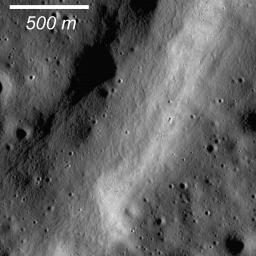
|
Pull Apart – Grabens
- Click the image above for a larger view
- Full-Res JPEG (1000 x 1000) (150.4 kB)
- Full-Res TIFF (1000 x 1000) (1.0 MB)
Caption:
Graben are common extensional features on the Moon as well as the other terrestrial planets and icy satellites. This graben (700 m wide) formed within a larger graben (1700 m). Illumination is the from the left.
Graben are extensional tectonic features in which a crustal block was down dropped between a pair of faults ("normal faults") when rock is pulled apart (tension). Normal-fault surfaces usually dip about 60 degrees, so the original fault scarp would have been steep as well. Over time, micrometeorite bombardment of the lunar surface results in a gardening of the regolith and the steep slopes become eroded to what is observed here. How does crust "pull-apart"? On the Earth, geologists often see pull-apart features in regions where plate motions are in opposite directions resulting in tension -- a zone of parallel faults occurs and grabens form. Lunar scientists have found no evidence of plate tectonics on the Moon -- the Moon is a one-plate planet. Tension zones on the Moon are usually found on the outer margins of mare basalt deposits. The mare have a relatively high density, weighing down the crust. As the crust sags beneath the mare, rocks in the central portions are put under compression, sometimes resulting in wrinkle ridges, and rocks at the margins are pulled apart resulting in grabens. The story is sometimes more complicated in areas where there are multiple large deposits. This particular graben, Rima Burg, cuts Lacus Mortis (Lake of Death) and extends into the adjacent highlands. Inspecting a lunar map shows that the local stresses in the crust may come from Frigoris or Serenitatis. Also, graben may follow pre-existing deep fractures in the crust from the formation of large basins.
Background Info:
NASA's Goddard Space Flight Center built and manages the mission for the Exploration Systems Mission Directorate at NASA Headquarters in Washington. The Lunar Reconnaissance Orbiter Camera was designed to acquire data for landing site certification and to conduct polar illumination studies and global mapping. Operated by Arizona State University, the LROC facility is part of the School of Earth and Space Exploration (SESE). LROC consists of a pair of narrow-angle cameras (NAC) and a single wide-angle camera (WAC). The mission is expected to return over 70 terabytes of image data.
Cataloging Keywords:
| Name | Value | Additional Values |
|---|---|---|
| Target | Moon | |
| System | Earth | |
| Target Type | Satellite | |
| Mission | Lunar Reconnaissance Orbiter (LRO) | |
| Instrument Host | Lunar Reconnaissance Orbiter | |
| Host Type | Orbiter | |
| Instrument | Lunar Reconnaissance Orbiter Camera (NAC) | |
| Detector | Narrow Angle Camera (NAC), Wide Angle Camera (WAC) | |
| Extra Keywords | Grayscale, Map | |
| Acquisition Date | ||
| Release Date | 2009-12-16 | |
| Date in Caption | ||
| Image Credit | NASA/GSFC/Arizona State University | |
| Source | photojournal.jpl.nasa.gov/catalog/PIA12933 | |
| Identifier | PIA12933 | |
